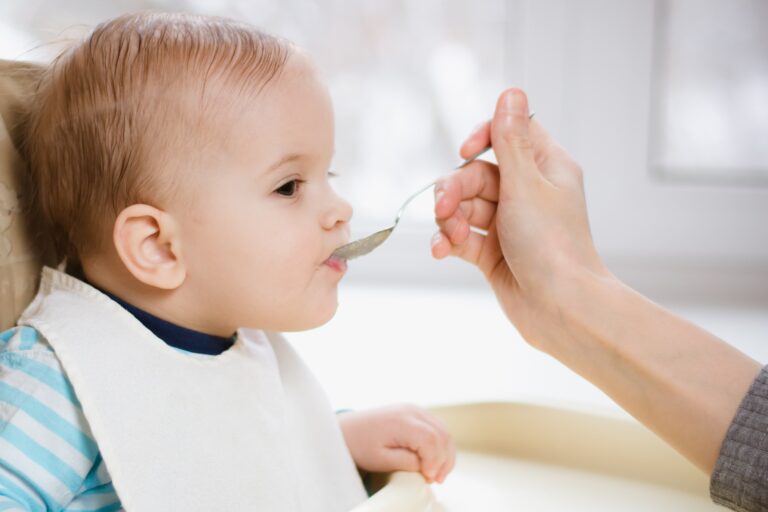How Much Feed Baby Solids: A Perfect Portion Guide
Introduce solids to your baby with a few teaspoons per meal, gradually increasing the amount. Babies typically start with solids at around 4 to 6 months of age.
Embarking on the journey of feeding your baby solids is a significant milestone. This transition to more complex foods complements breast milk or formula intake. Initially, your baby will only need small quantities to get accustomed to the new textures and flavors.
Experts recommend starting with just a couple of teaspoons of solid food once a day, and as your baby grows, you can increase the frequency and portions accordingly. It’s important to maintain a balance and ensure that your baby’s primary nutrition continues to come from breast milk or formula during the first year. Watch for your baby’s hunger cues and consult with your pediatrician for personalized advice tailored to your baby’s development and nutritional needs.
The First Bites: Introducing Solids
Starting your baby on solids is a big step! Timing is key, usually around 4 to 6 months old. Your little one should show signs of being ready. These signs include good head control, sitting well when supported, and showing curiosity about food.
Initial portion sizes should be small. Think about one to two teaspoons of pureed food. This will begin once a day. It’s not about replacing breast milk or formula; it’s about complementing it. Babies still get most of their nutrients from milk at this stage.
Adjust expectations; babies may eat very little at first. That’s totally fine. Eating solids at this age is about practice and exploration. Also, remember every baby is different. What’s important is that they’re introduced to a variety of tastes and textures safely and at a comfortable pace.
Reading Your Baby’s Hunger Cues
Noticing your baby’s hunger can be simple:
- Baby opens mouth or leans toward food?
- They might smack or lick their lips.
- Hand movements to the mouth can show hunger.
- Crying and fussiness often come later.
See these signs? It’s likely feeding time.
Meal Frequency And Progression
Introducing your little one to solid foods is an exciting milestone. At first, feed your baby just a bit to taste. Two to three teaspoons once a day is enough. Gradually increase the amount as your baby shows eagerness to eat more.
As your child grows, a few spoonfuls can become a small meal. Your baby will eventually enjoy three meals a day. Between 6 to 8 months, you might feed them two meals daily. By their first birthday, aim for three daily meals with some snacks.
Pay attention to your baby’s hunger cues. Let these signs guide you to increase meal frequency and portion size. Mealtimes should be happy, with a variety of healthy foods offered. Never force feed; let your baby’s appetite dictate.
Quantities And Types Of Solid Foods
Introducing solid foods to your baby is an exciting step. Let’s make it simple:
- At 4-6 months, begin with 1-2 teaspoons of pureed food.
- By 7-8 months, meals may be a mix of cereal, fruit, and vegetables.
- Offer 3-4 tablespoons per meal, spread over 2-3 meals daily.
Combine different textures and food groups for balanced nutrition:
| Age | Meals per Day | Amount per Meal |
|---|---|---|
| 9-11 months | 3 meals | 4-6 tablespoons of soft food |
| 12 months | 3 meals | 1/4 to 1/2 cup of food |
Remember to keep breast milk or formula as the main source.
Role Of Breastmilk Or Formula
Breastmilk or formula should remain a key source of nutrition for your baby. Even as solids are introduced, liquids are essential for hydration and development. Babies generally begin consuming solids around 6 months. Before this time, they get all necessary nutrients from breastmilk or formula.
Transitioning from milk to solids is a gradual process. Start with small amounts of baby-friendly solid foods. Solid feeds can increase as the baby grows. Your baby should still drink plenty of breastmilk or formula. Generally, babies drink less milk as they eat more solids. Each baby is different, and their needs will vary.
| Age | Milk Feedings | Solid Meals |
|---|---|---|
| 6-8 months | 5 to 6 times/day | 1 to 2 times/day |
| 9-12 months | 3 to 5 times/day | 2 to 3 times/day |
Avoiding Overfeeding
Knowing how much to feed your baby with solids is key. Babies signal when they had enough. Signs include turning their head away or not opening their mouth. Pushing food away is another hint. Listen to these cues to prevent overfeeding.
A balanced diet for your baby involves variety. Offer fruits, vegetables, grains, and proteins. Start with small amounts. You can increase portions as your baby grows.
| Age | Meals per Day | Portion Size |
|---|---|---|
| 6 months | 1-2 | 1-2 tablespoons |
| 9 months | 2-3 | 2-4 tablespoons |
| 12 months | 3 | 1/4 to 1/2 cup |
Creating A Feeding Schedule
Establishing a meal routine aids in smooth transitions from milk to solids for babies. Babies thrive on consistency, so a structured feeding schedule is beneficial. Start with breakfast, followed by lunch, and dinner.
| Age | Breakfast | Lunch | Dinner |
|---|---|---|---|
| 6 months | 8 AM | 12 PM | 5 PM |
| 9 months | 8 AM | Include a snack at 10 AM | 5 PM |
| 12 months | 8 AM | 12 PM | Snack at 3 PM and dinner at 5 PM |
The table above showcases a simple feeding timetable for babies. Snacks can be introduced between mealtimes. Ensure these are healthy and small portions. Sleep schedules are crucial; align nap times post mealtime to help digestion. This interplay between eating and sleeping is pivotal for a baby’s development. Parents should adjust times as needed for their baby’s hunger cues and sleep patterns.
Frequently Asked Questions Of How Much Feed Baby Solids
How Much Should I Feed My Baby Solids?
Start your baby with 1 to 2 teaspoons of pureed solid food once a day, gradually increasing as they get accustomed.
How Many Ounces Should A Baby Eat Chart?
A baby feeding chart by age in ounces is as follows: – Newborns: 1-2 ounces every 2-3 hours – 1 month old: 4 ounces every 4 hours – 2 months old: 4-5 ounces every 3-4 hours – 4 months old: 4-6 ounces every 4-5 hours – 6 months old: 6-8 ounces every 4-5 hours – 9 months old: 7-8 ounces every 6 hours Remember, these are general guidelines and babies’ needs may vary.
How Much Puree Should A 6 Month Old Eat?
A 6-month-old should start with 1-2 teaspoons of puree, gradually increasing as they tolerate.
Conclusion
Navigating the journey of introducing solids to baby’s diet can seem daunting. Yet, with the right approach, it’s rewarding for both parents and infants. Trust your intuition, watch for hunger cues, and communicate with your pediatrician to tailor feeding practices.
As each baby’s needs differ, flexibility and patience become key. Remember to enjoy this milestone and the messy, joyous moments that come with it!






